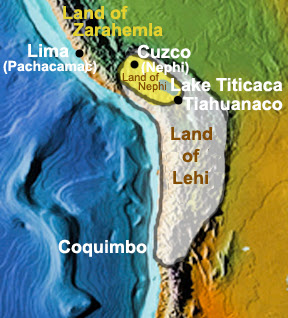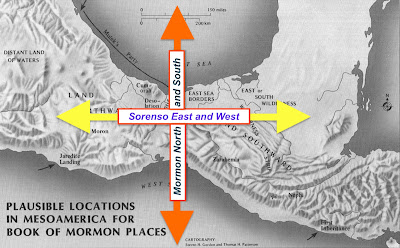So much has been said and written by both adherents and critics to the
Book of Mormon, including several articles we, ourselves, have added, that
perhaps another article on the subject is a bit redundant; however, the subject
keeps circulating, especially among the critics and the uninformed, that cause
some difficulty for trusting members regarding the accuracy of the Book of
Mormon.
First of all, there were two manuscripts. The first was the original manuscript—the text written down by scribes as Joseph Smith translated the Book of Mormon. Most of this manuscript has been destroyed over time by mold and water seepage. Only 28 percent of the original is extant. The printer's manuscript—the handwritten copy that was made to take to the printer for typesetting.
Most every member knows that Joseph Smith, of course, translated the
scriptural record, but not everyone knows that the spelling in the first
edition was that of Oliver Cowdery, and the punctuation was that of the chief
compositor, John H. Gilbert, the non-Mormon typesetter who worked
for E. B. Grandin, publisher of that edition. When the text was first
delivered for printing, it was “found that the manuscript was closely written and
legible, but not a punctuation mark from beginning to end,” Gilbert later
wrote.
It might be of interest to
know that five-sixths of the 1830 Book of Mormon was set from the specially
prepared copy of the original manuscript, called the printer’s manuscript,
which was standard practice of the day, however, one-sixth (from Helaman 13:17
to the end of Mormon) was set from the original (dictated) manuscript—the copy
prepared specifically for the 1830 typesetter to use as his copytext. The reason for the switch was the need to take the printer’s manuscript to
Canada in February 1830 in order to secure the copyright of the Book of Mormon
within the British empire. During the time that Oliver Cowdery and others were
on their trip to nearby Canada with the printer’s manuscript, the 1830
typesetter used the original manuscript to set the type, although he
himself was unaware that there had been a temporary switch in the manuscripts
(According to Stephen Ehat’s discussion
of Joseph Smiths efforts in early 1830 to get the copyright of the Book of
Mormon secured in Canada; BYU Studies, volume 50, number 2, pages 4-70).
“According
to Gilbert, it was Hyrum Smith who brought the first twenty-four pages of the
handwritten printer’s manuscript to the publisher. As the compositor said:
“He had it under his vest, and vest and coat closely buttoned over it. At night [Hyrum] came and got the manuscript, and with the same precaution carried it away. The next morning with the same watchfulness, he brought it again, and at night took it away. On the second day—[Martin Harris] and [Hyrum] being in the office—I called their attention to a grammatical error, and asked whether I should correct it? Harris consulted with [Hyrum] a short time, and turned to me and said: ‘The Old Testament is ungrammatical, set it as it is written.”
After working in that manner a few days, Gilbert suggested to Hyrum when being given the manuscript for the day’s work: “Mr. Smith, if you would leave this manuscript with me, I would take it home with me at night and read and punctuate it.” Hyrum replied to this: “We are commanded not to leave it.” A few mornings after this, when [Hyrum] handed me the manuscript, he said to me: ‘if you will give your word that this manuscript shall be returned to us when you get through with it, I will leave it with you.’”
For two or three nights Gilbert took it home and punctuated it with a lead pencil” resulting in Gilbert’s effort of somewhere between 30,000–35,000 additional punctuation marks (Wilford C. Wood, Joseph Smith Begins His Work, vol. 1, Salt Lake City: Wilford C. Wood, 1959).
Typesetting from the Oliver Cowdery’s handwritten (copy) printer’s manuscript commenced in August of 1829 and by March of the following year was completed—a little over six-and-a-half months. During this time, Joseph Smith had had little to do with the supervision of the printing for the first edition, being in Grandin’s printshop only once for about fifteen minutes during that time.
As soon as the first edition was out,
readers began finding typographical, spelling, and grammatical errors. On 25
June 1833, Joseph wrote to printer W. W. Phelps, “As soon as we can get time,
we will review the manuscripts of the Book of Mormon, after which they will be
forwarded to you.” (HC, 1:363.)
With the help of Oliver Cowdery, the Prophet prepared the second (1837) edition. At this point, they made over one thousand corrections—most of them grammatical and added some minor clarifications. By this time, the Prophet, who had limited formal schooling, was learning the rudiments of Hebrew, and English grammar. (HC, 2:390, 474; 3:26.)
Both the 1840 and 1842 editions were carefully revised by Joseph Smith. By now, however, Oliver Cowdery had left the Church, taking the printer’s manuscript with him.
As late as 15 January 1842 Joseph Smith was still making corrections himself. He recorded: “I commenced reading the Book of Mormon, at page 54, … (the previous pages having been corrected), for the purpose of correcting the stereotype plates of some errors which escaped notice in the first edition” (HC, 4:494.)
Because the first European edition in English followed the 1837 edition, it did not contain some of these changes made by Joseph Smith. So later American editions, which were taken from the first European edition, perpetuated these omissions.
John Taylor assigned Orson Pratt to
prepare a new edition of the book in 1879. Elder Pratt redivided the chapters
(increasing them from 114 to 239)—and added verse numbers and references. After
the turn of the century, President Heber J. Grant called James E. Talmage to
prepare a new edition. The 1920 edition included double-column pages, revised
references, a pronouncing vocabulary, an index, and many grammatical
improvements. And, most recently, the 1981 edition was prepared under the
supervision of the Scriptures Publication Committee, under direction of the
First Presidency.
(See the next post,” Textual Changes in the Book of Mormon – Part II,”for more on the early editions of the Book of Mormon).
First of all, there were two manuscripts. The first was the original manuscript—the text written down by scribes as Joseph Smith translated the Book of Mormon. Most of this manuscript has been destroyed over time by mold and water seepage. Only 28 percent of the original is extant. The printer's manuscript—the handwritten copy that was made to take to the printer for typesetting.
The printer’s manuscript
of the Book of Mormon, like the original, was written without punctuation
Façade of the Grandin
print shop on Main Street in Palmyra, New York, after being restored by the
Church. The Book of Mormon was first published here in 1830
(Left:) John H. Gilbert, Jr., in 1890, stating in recollection: “I
punctuated it to make it read as I supposed the Author intended, and but very
little punctuation was altered in proofreading; (Right) The work of a
compositor or typesetter in the early days of printing
“He had it under his vest, and vest and coat closely buttoned over it. At night [Hyrum] came and got the manuscript, and with the same precaution carried it away. The next morning with the same watchfulness, he brought it again, and at night took it away. On the second day—[Martin Harris] and [Hyrum] being in the office—I called their attention to a grammatical error, and asked whether I should correct it? Harris consulted with [Hyrum] a short time, and turned to me and said: ‘The Old Testament is ungrammatical, set it as it is written.”
After working in that manner a few days, Gilbert suggested to Hyrum when being given the manuscript for the day’s work: “Mr. Smith, if you would leave this manuscript with me, I would take it home with me at night and read and punctuate it.” Hyrum replied to this: “We are commanded not to leave it.” A few mornings after this, when [Hyrum] handed me the manuscript, he said to me: ‘if you will give your word that this manuscript shall be returned to us when you get through with it, I will leave it with you.’”
For two or three nights Gilbert took it home and punctuated it with a lead pencil” resulting in Gilbert’s effort of somewhere between 30,000–35,000 additional punctuation marks (Wilford C. Wood, Joseph Smith Begins His Work, vol. 1, Salt Lake City: Wilford C. Wood, 1959).
Typesetting from the Oliver Cowdery’s handwritten (copy) printer’s manuscript commenced in August of 1829 and by March of the following year was completed—a little over six-and-a-half months. During this time, Joseph Smith had had little to do with the supervision of the printing for the first edition, being in Grandin’s printshop only once for about fifteen minutes during that time.
The time-line for the
1829-30 edition of the Book of Mormon—as Oliver Cowdery described these early
days: “Days never to be forgotten—to
sit under the sound of a voice dictated by the inspiration of heaven, awakened
the utmost gratitude in this bosom! Day after day I continued, uninterrupted,
to write from his mouth, as he translated with the urim and thummim”
With the help of Oliver Cowdery, the Prophet prepared the second (1837) edition. At this point, they made over one thousand corrections—most of them grammatical and added some minor clarifications. By this time, the Prophet, who had limited formal schooling, was learning the rudiments of Hebrew, and English grammar. (HC, 2:390, 474; 3:26.)
Both the 1840 and 1842 editions were carefully revised by Joseph Smith. By now, however, Oliver Cowdery had left the Church, taking the printer’s manuscript with him.
As late as 15 January 1842 Joseph Smith was still making corrections himself. He recorded: “I commenced reading the Book of Mormon, at page 54, … (the previous pages having been corrected), for the purpose of correcting the stereotype plates of some errors which escaped notice in the first edition” (HC, 4:494.)
Because the first European edition in English followed the 1837 edition, it did not contain some of these changes made by Joseph Smith. So later American editions, which were taken from the first European edition, perpetuated these omissions.
The printing press on the
third floor of the E.B. Grandin Building on Main Street in Palmyra, New York,
where the Book of Mormon was first published in 1830
(See the next post,” Textual Changes in the Book of Mormon – Part II,”for more on the early editions of the Book of Mormon).































